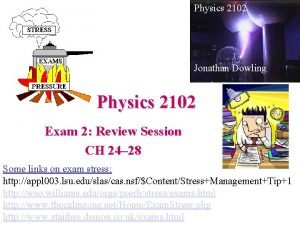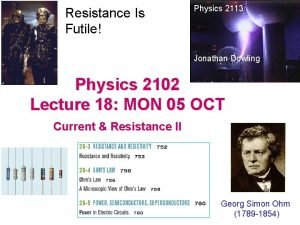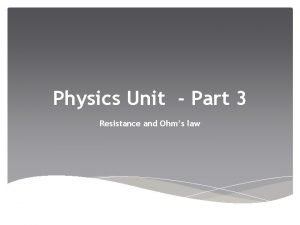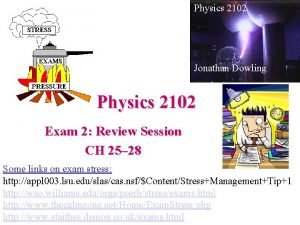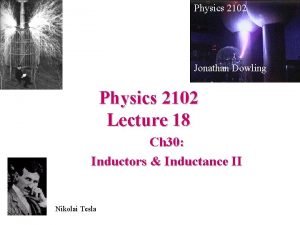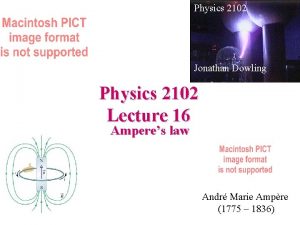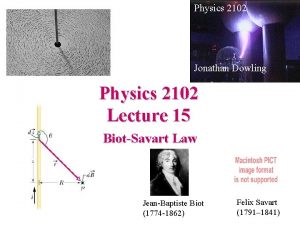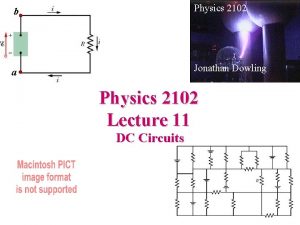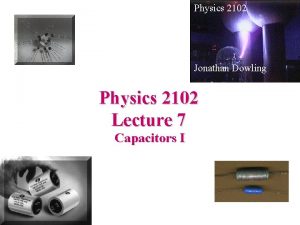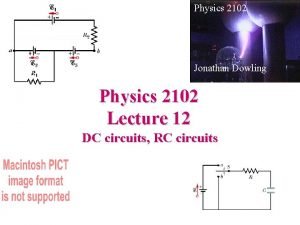Resistance Is Futile Physics 2102 Jonathan Dowling Physics









![L A= r 2 A Current Density: J=i/A Units: [A/m 2] Resistance: R= L/A L A= r 2 A Current Density: J=i/A Units: [A/m 2] Resistance: R= L/A](https://slidetodoc.com/presentation_image_h2/0d0ee99b632d0e30f26376142c12d887/image-10.jpg)










- Slides: 20

Resistance Is Futile! Physics 2102 Jonathan Dowling Physics 2102 Lecture 10: TUE 23 FEB Current & Resistance I Georg Simon Ohm (1789 -1854)

EXAM I AVERAGE: 55/100 STANDARD DEVIATION: 15/100 APPROXIMATE EXAM I LETTER GRADE: A=100– 80 B=79– 70 C=69– 40 D=39– 30 F=29– 0 We do not assign an official letter grade for any midterm exam so the above breakdown is an unofficial guide for use by students in our section only; to give you an APPROXIMATE idea of where you stand. The Exam I solutions have been posted at: http: //www. phys. lsu. edu/classes/spring 2010/phys 2102/exam 1 solutions. pdf

Exam I: Problem 2 — Integration with Cylindrical Shells dr Qenc ≠ V unless is a contant! = ar 2 is NOT a constant! d. V L (a) (b)

Resistance is NOT Futile! Electrons are not “completely free to move” in a conductor. They move erratically, colliding with the nuclei all the time: this is what we call “resistance”. The resistance is related to the potential we need to apply to a device to drive a given current through it. The larger the resistance, the larger the potential we need to drive the same current. Ohm’s laws Georg Simon Ohm (1789 -1854) "a professor who preaches such heresies is unworthy to teach science. ” Prussian minister of education 1830 Devices specifically designed to have a constant value of R are called resistors, and symbolized by

Current Density and Drift Speed The current is the flux of the current density! If surface is perpendicular to a constant electric field, then i=JA, or J=i/A d. A J E Units: i Drift speed: vd : Velocity at which electrons move in order to establish a current. Charge q in the length L of conductor: L n =density of electrons, e =electric charge A E i

Resistivity and resistance Metal “field lines” These two devices could have the same resistance R, when measured on the outgoing metal leads. However, it is obvious that inside of them different things go on. resistivity: Resistivity is associated ( resistance: R=V/I ) with a material, resistance with respect to a device constructed with the material. Example: A - L V + Makes sense! For a given material:

Resistivity and Temperature Resistivity depends on temperature: = 0(1+a (T-T 0) ) • At what temperature would the resistance of a copper conductor be double its resistance at 20. 0°C? • Does this same "doubling temperature" hold for all copper conductors, regardless of shape or size?

b a Power in electrical circuits A battery “pumps” charges through the resistor (or any device), by producing a potential difference V between points a and b. How much work does the battery do to move a small amount of charge dq from b to a? d. W = –d. U = -dq • V = (dq/dt) • dt • V= i. V • dt The battery “power” is the work it does per unit time: P = d. W/dt = i. V P=i. V is true for the battery pumping charges through any device. If the device follows Ohm’s law (i. e. , it is a resistor), then V=i. R and P = i. V = i 2 R = V 2/R

Ohm’s Law and Power in Resistors Watt? You Looking At! Ohm’s Law Power Dissipated by a Resistor:
![L A r 2 A Current Density JiA Units Am 2 Resistance R LA L A= r 2 A Current Density: J=i/A Units: [A/m 2] Resistance: R= L/A](https://slidetodoc.com/presentation_image_h2/0d0ee99b632d0e30f26376142c12d887/image-10.jpg)
L A= r 2 A Current Density: J=i/A Units: [A/m 2] Resistance: R= L/A Resitivity: depends only on Material and Temperature. Units: [ • m]

Example A human being can be electrocuted if a current as small as i=100 m. A passes near the heart. An electrician working with sweaty hands makes good contact with the two conductors he is holding. If his resistance is R=1500 , what might the fatal voltage be? (Ans: 150 V) Use: V=i. R

Example Two conductors are made of the same material and have the same length. Conductor A is a solid wire of diameter r=1. 0 mm. Conductor B is a hollow tube of outside diameter 2 r=2. 0 mm and inside diameter r=1. 0 mm. What is the resistance ratio RA/RB, measured between their ends? A R= L/A B AA= r 2 AB= ((2 r)2 -r 2)=3 r 2 RA/RB= AB/AA= 3 LA=LB=L Cancels

Integration with Cylindrical Shells dr ienc ≠ J • A unless J is constant! J(r) = ar 2 is NOT a constant! i d. A L

Example A P=1250 Watt radiant heater is constructed to operate at V=115 Volts. (a) What will be the current in the heater? (b) What is the resistance of the heating coil? (c) How much thermal energy is produced in 1. 0 hr by the heater? • Formulas: P=i 2 R=V 2/R; V=i. R • Know P, V; need R to calculate current! • P=1250 W; V=115 V => R=V 2/P=(115 V)2/1250 W=10. 6 • i=V/R= 115 V/10. 6 =10. 8 A • Energy? P=d. U/dt => U=P • t = 1250 W 3600 sec= 4. 5 MJ = 1. 250 k. W • hr

Example A 100 W lightbulb is plugged into a standard 120 V outlet. (a) What is the resistance of the bulb? (b) What is the current in the bulb? (c) How much does it cost per month to leave the light turned on continuously? Assume electric energy costs 6¢/k. W·h. (d) Is the resistance different when the bulb is turned off? • Resistance: same as before, R=V 2/P=144 • Current, same as before, i=V/R=0. 83 A • We pay for energy used (k. W h): U=Pt=0. 1 k. W (30 24) h = 72 k. W h => $4. 32 • (d): Resistance should be the same, but it’s not: resistivity and resistance increase with temperature. When the bulb is turned off, it is colder than when it is turned on, so the resistance is lower.

Example An electrical cable consists of 105 strands of fine wire, each having 2. 35 resistance. The same potential difference is applied between the ends of all the strands and results in a total current of 0. 720 A. (a) What is the current in each strand? i=I/105=0. 720 A/105=[0. 00686] A (b) What is the applied potential difference? V=i. R=[0. 016121] V (c) What is the resistance of the cable? R=V/I=[. 0224 ]

i V P = i. V U = Pt t in seconds V i P = i. V [J/s is Watt] P = i. V [Watt is J/s]

Rd = 1. 0 x 105 im = 1 x 10– 3 A Rw = 1. 5 x 103 im = V 1 = i m. R d i 1 = V 1/Rw V 2 = i m. R w

My House Has Two Front Porch Lights. Each Light Has a 100 W Bulb. The Lights Come on at Dusk and Go Off at Dawn. How Much Does this Cost Me Per Year? Two 100 W Bulbs @ 12 Hours Each = One 100 W @ 24 Hours. P = 100 W = 0. 1 k. W T = 365 Days x 24 Hours/Day = 8670 Hours Demco Rate: D = 0. 1797$/k. W • Hour (From My Bill!) Cost = Px. Tx. D = (0. 1 k. W)x(8670 Hours)x(0. 1797$/k. W • Hour) = $157. 42 = 13 shots of Goldschläger!

 E=q/ae0
E=q/ae0 Jonathan dowling
Jonathan dowling Dimension of electric resistance
Dimension of electric resistance Dowling optical
Dowling optical Dowling roundabout
Dowling roundabout International human resource management dowling 6th edition
International human resource management dowling 6th edition Shock mnemonic
Shock mnemonic Define futile care
Define futile care The futile search for stability
The futile search for stability Chose futile
Chose futile After hours of futile debate
After hours of futile debate What does indolent mean in the most dangerous game
What does indolent mean in the most dangerous game What is a force that opposes motion through direct contact
What is a force that opposes motion through direct contact Filter medium resistance formula
Filter medium resistance formula Nutrition 2102
Nutrition 2102 Nutrition 2102
Nutrition 2102 Ift-2102
Ift-2102 Nutrition 3102
Nutrition 3102 Sos.texas.gov form 2102
Sos.texas.gov form 2102 Resistance physics
Resistance physics Ohm unit
Ohm unit

